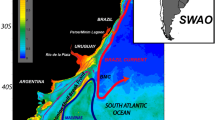Abstract
Based on a ship survey during January 1998, the characteristics of the flow, the thermohaline properties and the volume transport of the Arabian Sea are discussed. A strong westward flow exists between 10.5°N and 11°N, part of which turns to the south as the Somali current near the coast at about 10°N and the rest turns north. At the passage between the African continent and the Socotra Island, the northern branch separates into two flows: the left one enters the passage and the right one flows eastward along the southern slope of the island. Off the island the flow separates once more, most of it meandering northeast and a small fraction flowing southeast. Volume transport calculation suggests that the tidal transport is one or two orders of magnitude smaller than the total transport in this region and it becomes more important near the coast. The average velocity of the flow in the upper layer (0–150 m) is about 20 cm s−1, with a maximum of 53 cm s−1 appearing east of the Socotra Island, and the subsurface layer (200–800 m) has an average velocity of 8.6 cm s−1; the velocity becomes smaller at greater depths. The depth of the seasonal thermocline is about 100 m, above which there is a layer with well mixed temperature and dissolved oxygen. High-salinity and oxygen-rich water appears near the surface of the northern Arabian Sea; a salinity maximum and oxygen minimum at 100 m depth along 8°N testifies the subduction of surface water from the northern Arabian Sea. Waters from the Red Sea and the Persian Gulf also influence the salinity of the area.
Similar content being viewed by others
References
Anderson, D. L. T., D. J. Carrington, R. Correy, and C. Gordon, 1991. Modeling the variability of the Somali Current. J. Mar. Res., 49: 659–696.
Bruce, J. G., 1979. Eddies off the Somali coast during the southwest monsoon. J. Geophys. Res., 84: 7742–7748.
Bruce, J. G., D. R. Quadfasel, and J. C. Swallow, 1980. Somali eddy formation during the commencement of the southwest monsoon, 1978. J. Geophys. Res., 85: 6654–6660.
Bruce, J. G., M. Fieux, and J. Gonella, 1981. A note on the continuance of the Somali eddy after the cessation of the Southwest monsoon. Oceanogr. Acta, 4: 7–9.
Dueing, W., and A. Leetmaa, 1980. Arabian Sea cooling: A preliminary heat budget. J. Phys. Oceanogr., 10: 307–312.
Fischer, J., F. Schott, and L. Stramma, 1996. Currents and transports of the Great Whirl—Socotra Gyre system during the Summer Monsoon, August 1993. J. Geophys. Res., 101: 3 573–3 587.
Le Provost, C., F. H. Lyard, J. M. Molines, M. L. Genco, and F. Rabilloud, 1998. A hydro-dynamic ocean tide model improved by assimilating a satellite altimeter derived data set. J. Geophys. Res., 103: 5 513–5 530.
Luther, M. E., and J. J. O’Brien, 1985. A model of the seasonal circulation in the Arabian Sea forced by observed winds. Prog. Oceanogr., 14: 353–385.
McCreary, J. P. Jr., P. K. Kundu, and R. L. Molinari, 1993. A numerical investigation of dynamics, thermodynamics and mixed layer process in the Indian Ocean. Prog. Oceanogr., 31: 181–244.
Molinari, R. L., D. Olson, and G. Reverdin, 1990. Surface current distributions in the tropical Indian Ocean derived from complications of surface buoy trajectories. J. Geophys. Res., 95: 7 217–7 238.
Quadfasel, D., and F. Schott, 1983. Southward subsurface flow below the Somali Current. J. Geophys. Res., 88: 5 973–5 979.
Schott, F., 1983. Monsoon response of the Somali Current and associated upwelling. Prog. Oceanogr., 12: 357–381.
Schott, F., J. C. Swallow, and M. Fieux, 1990. The Somali Current at the equator: annual cycle of the currents and transports in the upper 1 000 m and connection to neighboring latitudes. Deep-Sea Res., 37: 1 825–1 848.
Schott, F., and J. Fischer, 2000. The winter monsoon circulation of the northern Arabian Sea and Somali Current. J. Geophys. Res., 105(C3): 6 359–6 376.
Schott, F., and J. McCreary, 2001. The monsoon circulation of the Indian Ocean. Prog. Oceanogr., 51: 1–123.
Stramma, L., P. Brandt, F. Schott, D. Quadfasel, and J. Fischer, 2002. Winter and summer monsoon water mass, heat and freshwater transport changes in the Arabian Sea near 8°N. Deep-Sea Res. II, 49: 1 173–1 195.
Wyrtki, K., 1971. Oceanography Atlas of the International Indian Ocean Expedition. National Science Foundation, Washington D.C., 531pp.
Author information
Authors and Affiliations
Corresponding author
Rights and permissions
About this article
Cite this article
Chen, M., Zuo, J., Li, P. et al. Current and thermohaline characteristics of the Arabian Sea during January 1998. J Ocean Univ. China 6, 117–124 (2007). https://doi.org/10.1007/s11802-007-0117-3
Received:
Accepted:
Issue Date:
DOI: https://doi.org/10.1007/s11802-007-0117-3




